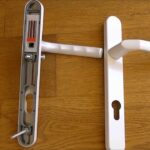UPVC door handles are an essential component of modern doors, offering durability, security, and aesthetic appeal. Whether you’re upgrading your home or replacing a worn-out handle, understanding the different types, benefits, and maintenance tips can help you make an informed decision. This article explores everything you need to know about UPVC door handles, from their features to installation and maintenance.
What Are UPVC Door Handles?
UPVC Door Handles are specifically designed for doors made of UPVC material. These handles are known for their durability, weather resistance, and ease of maintenance, making them a popular choice for residential and commercial properties. They come in various designs, finishes, and functionalities to suit different door types.
Types of UPVC Door Handles
Lever/Lever UPVC Door Handles
This is the most common type of UPVC door handle. It consists of a lever on both the inside and outside of the door, allowing for easy operation. These handles are often used with multipoint locking systems to enhance security.
Lever/Pad UPVC Door
This type features a lever handle on the inside and a pad-style handle on the outside. The design ensures that the external handle remains static unless the key is turned, offering additional security.
Offset UPVC Door
Offset handles have a different positioning for the internal and external levers, making them suitable for specific door locking mechanisms. They are often used in specialized UPVC door systems.
Inline UPVC Door
These handles have levers that align perfectly, meaning both sides of the handle operate in the same direction. They are commonly found on doors with simple locking mechanisms.
Key Features of UPVC Door Handles
Durability and Weather Resistance
UPVC handles are designed to withstand extreme weather conditions, making them ideal for exterior doors. They do not corrode or rust, ensuring longevity.
Enhanced Security
Most UPVC door are equipped with multipoint locking systems that provide superior security compared to traditional handles.
Aesthetic Appeal
Available in various finishes, including chrome, brass, white, and black, UPVC door handles can complement different door styles and home decor.
Ergonomic Design
UPVC handles are designed for ease of use, ensuring smooth operation without requiring excessive force.
Compatibility with Various Locking Mechanisms
These handles work with different types of locking systems, including Euro cylinder locks and multipoint locks, making them highly versatile.
How to Choose the Right UPVC Door Handle
Consider the Handle Type
Choose between lever/lever, lever/pad, inline, or offset handles based on your door’s locking mechanism and security requirements.
Check Measurements
Before purchasing a replacement handle, measure the following key dimensions:
- PZ Measurement (Distance Between Keyhole and Spindle)
- Screw Hole Spacing
- Handle Length and Backplate Dimensions
Select the Right Finish
Match the handle finish with your door’s aesthetics for a seamless look.
Ensure Compatibility with the Locking System
Different UPVC handles are designed for specific locking mechanisms, so verify compatibility before purchase.
Choose High-Quality Materials
Opt for handles made from premium materials that offer durability and security, such as stainless steel or aluminum alloy.
Installation Guide for UPVC Door Handles
Tools Required:
- Screwdriver
- Measuring Tape
- Replacement Handle
- Allen Key (if applicable)
Steps for Installation:
Remove the Existing Handle: Use a screwdriver to unscrew the old handle from the door.
Measure and Align the New Handle: Ensure the screw holes and spindle align correctly.
Insert the Spindle and Secure the Handle: Fit the new handle in place and tighten the screws.
Test the Handle: Check for smooth operation and proper locking functionality.
Maintenance Tips for UPVC Door
Regular Cleaning
Wipe the handles with a soft cloth and mild detergent to remove dirt and grime. Avoid using abrasive cleaners that can damage the finish.
Lubricate Moving Parts
Apply a light lubricant to the spindle and locking mechanism to ensure smooth operation and prevent stiffness.
Check for Loose Screws
Periodically inspect the handle screws and tighten them if necessary to maintain stability.
Avoid Excessive Force
Use gentle pressure when operating the handle to prevent wear and tear.
Common Issues with UPVC Door and How to Fix Them
Handle is Loose
Solution: Tighten the screws on the backplate.
Handle is Stiff or Difficult to Operate
Solution: Lubricate the spindle and check for obstructions in the lock mechanism.
Handle Does Not Return to Horizontal Position
Solution: The spring cassette may be worn out and needs replacement.
Key Won’t Turn in the Lock
Solution: Check for debris inside the keyhole and ensure the locking mechanism is aligned properly.
Where to Buy UPVC Door Handles
You can purchase UPVC door from hardware stores, home improvement centers, and online marketplaces. Some popular online retailers include:
- Amazon – Offers a wide variety of designs and brands.
- eBay – Good for finding affordable and rare handle types.
- Specialist Hardware Stores – Provide expert guidance and high-quality selections.
- Manufacturer Websites – Buying directly ensures authenticity and warranty coverage.
Conclusion
UPVC door handles are a crucial component of modern doors, combining security, functionality, and style. Whether you’re replacing an old handle or upgrading your home, understanding the different types, features, and maintenance tips will help you make the best choice. Investing in a high-quality UPVC door handle enhances both the security and aesthetic appeal of your door, ensuring long-term reliability and performance.

